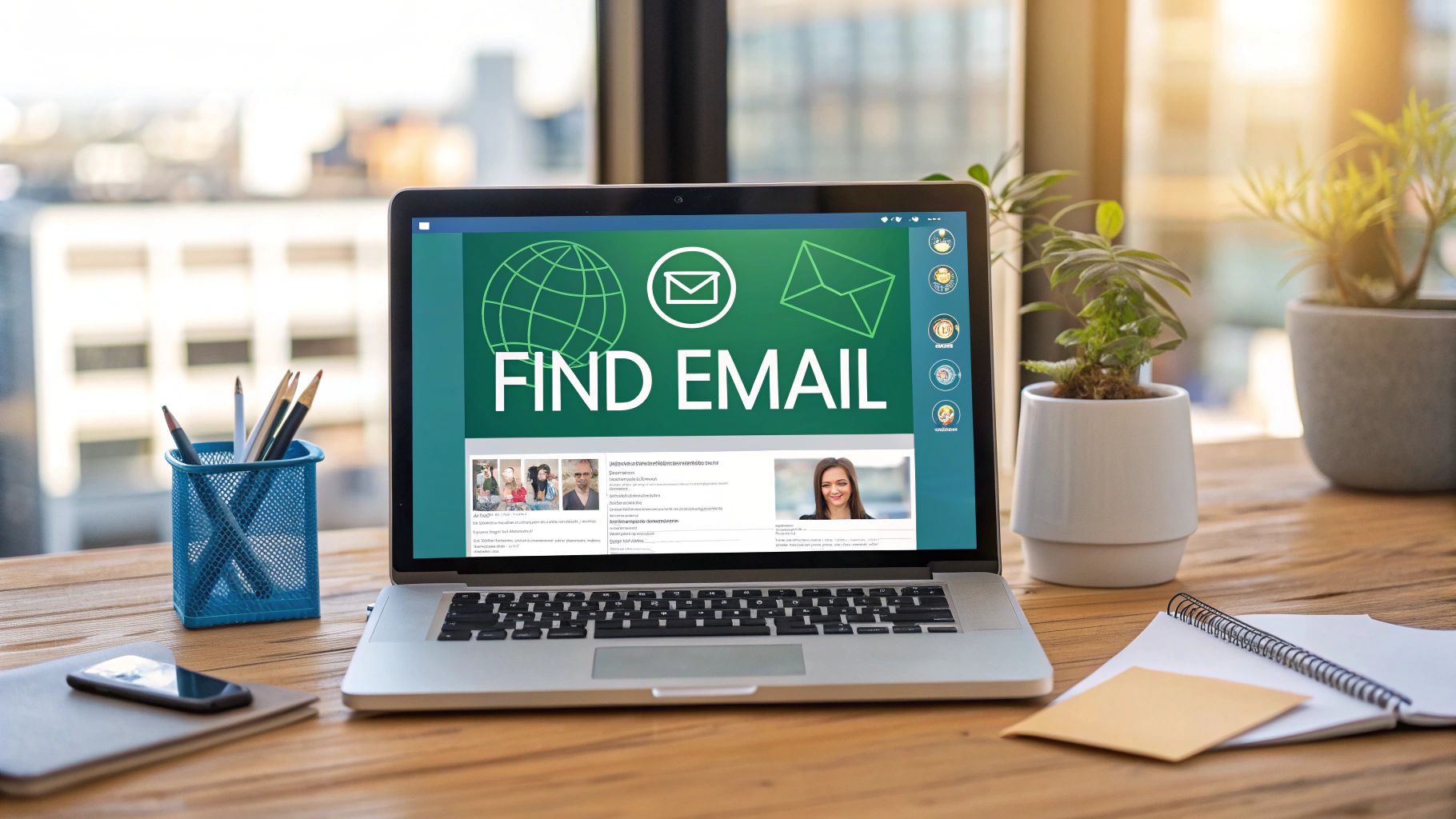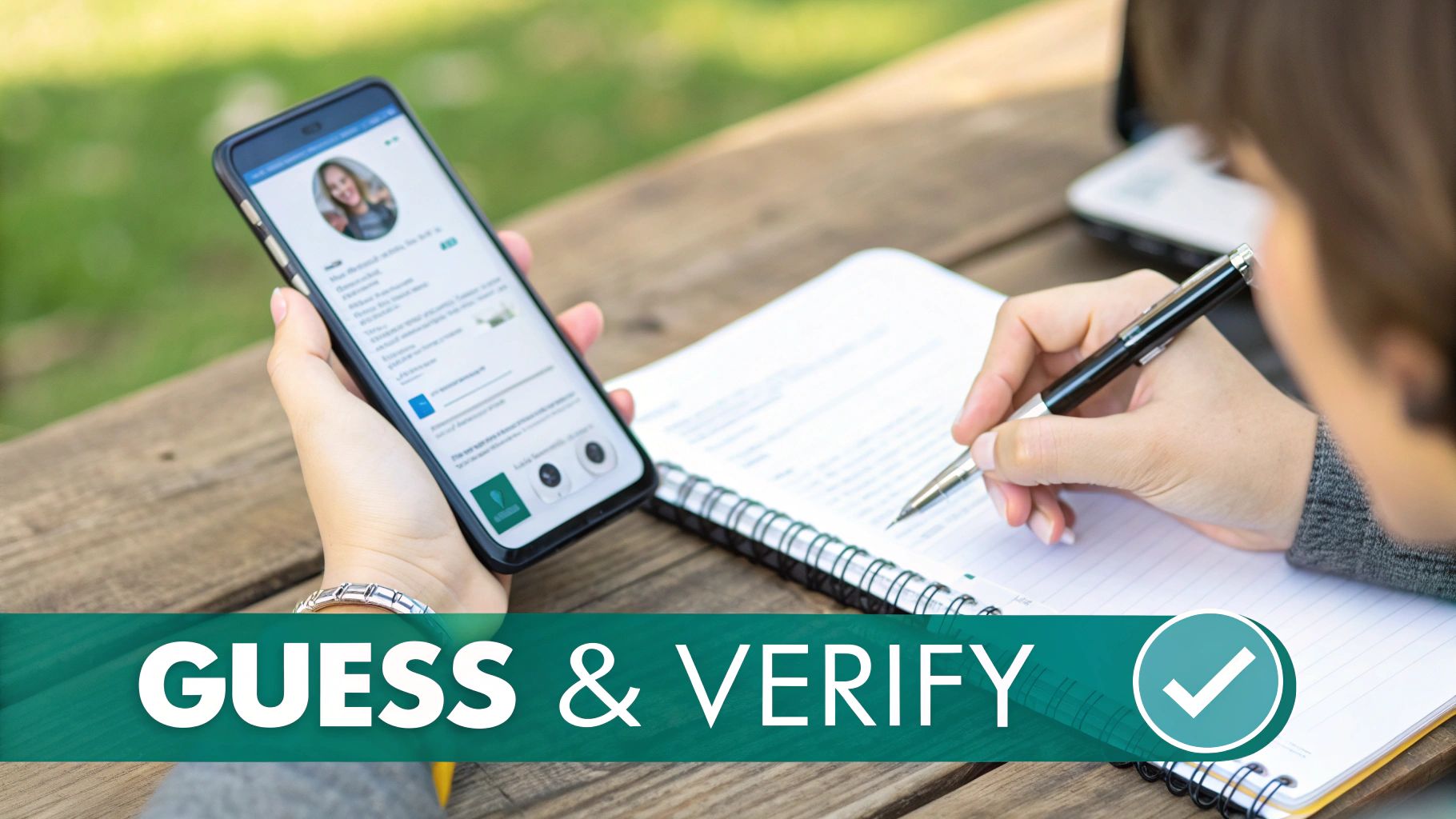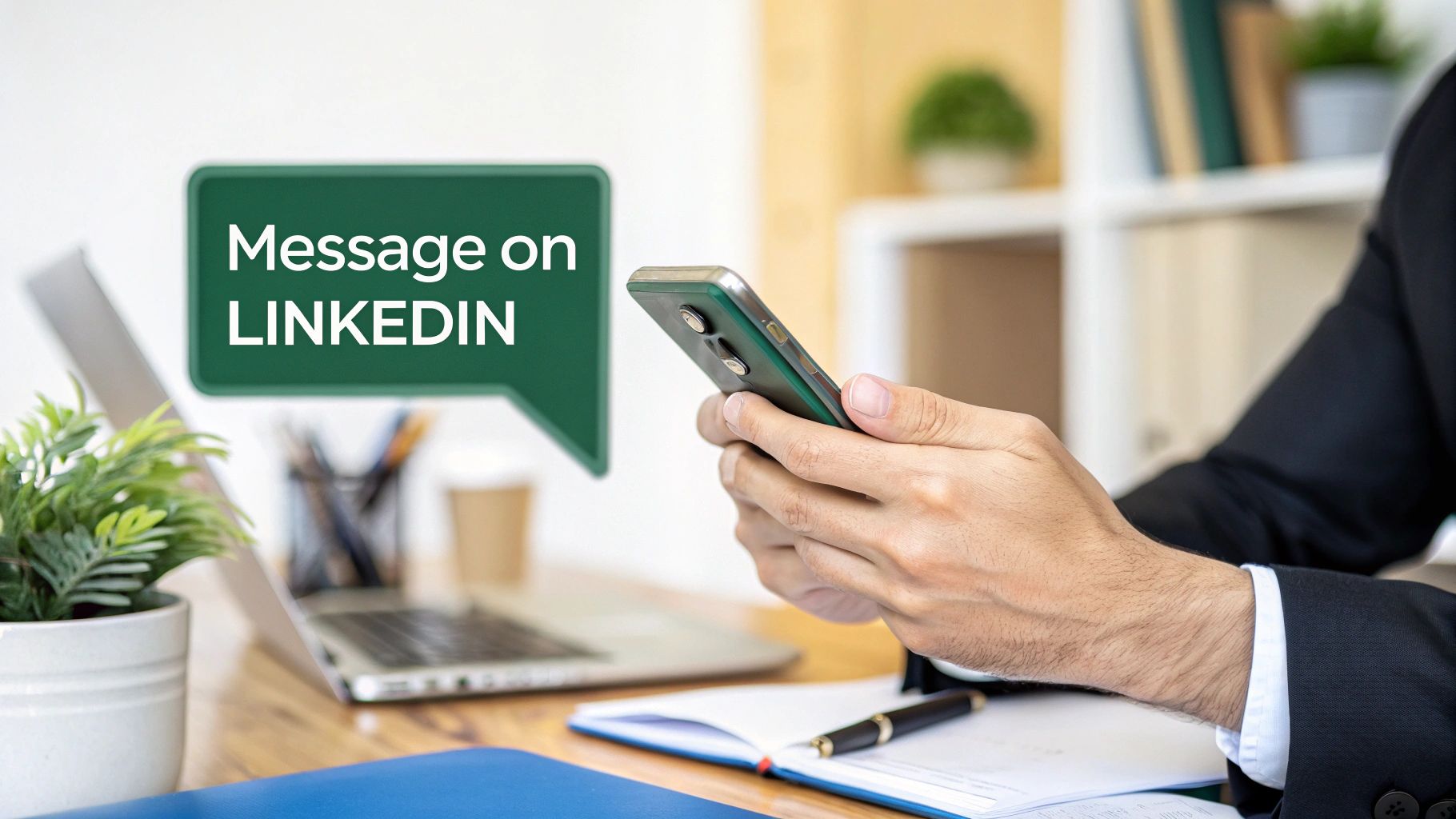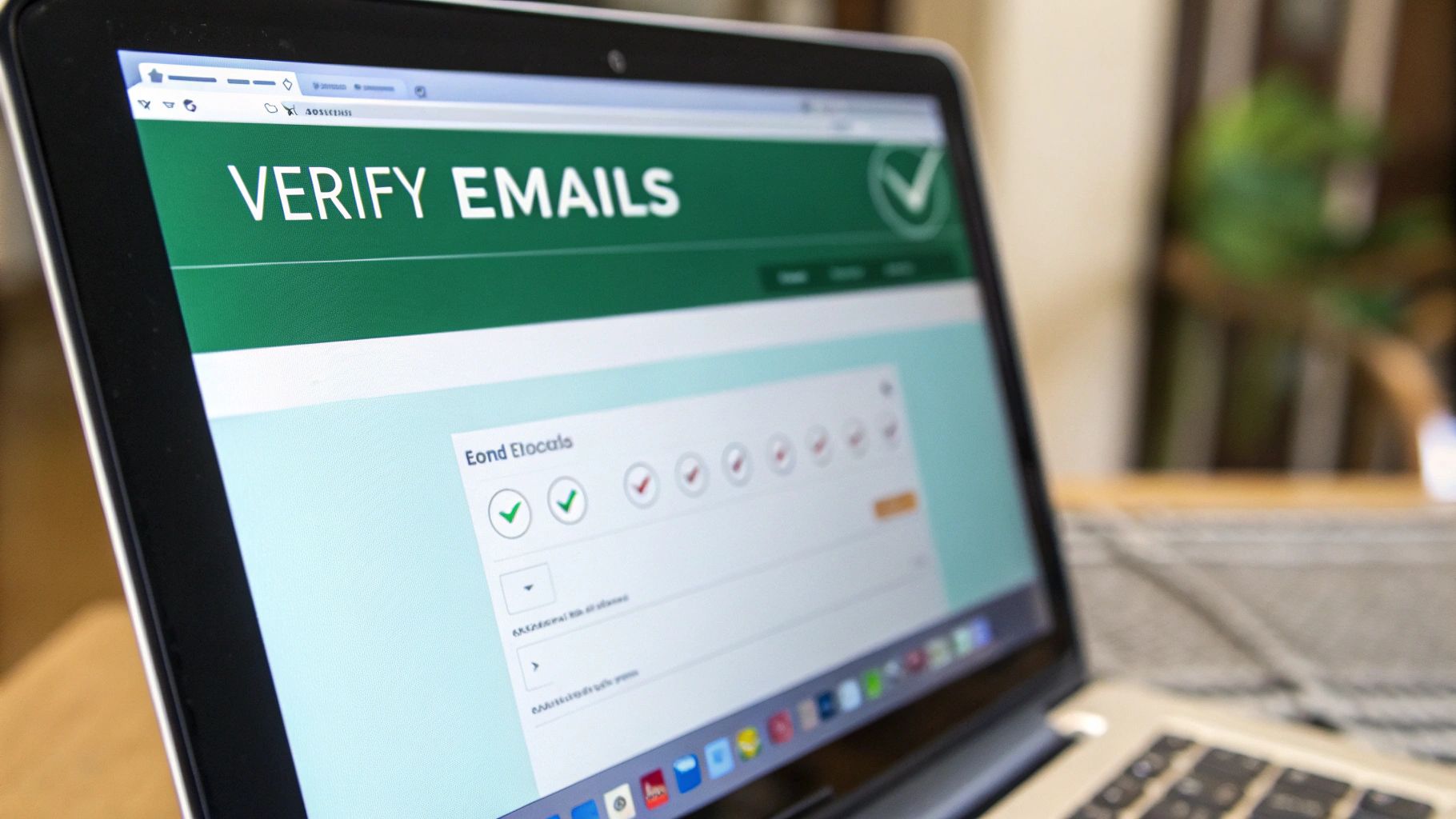When you're trying to find someone's email on LinkedIn, you've really got two paths you can take: the old-fashioned manual detective work or letting smart technology do the heavy lifting. The manual way means digging through their contact info section and maybe their company website. The faster route? Using a tool like the EmailScout Chrome extension to pull it up with a click.
Why Finding Emails on LinkedIn Is a Game Changer
Before we get into the how, let's talk about why this is such a valuable skill for any professional today. This isn't about finding new ways to spam people. It's about forging direct, meaningful connections that cut through all the digital noise. LinkedIn's InMail is fine, but a well-written email just feels more personal and almost always gets more attention.
Shifting a conversation from a busy social platform to a professional inbox is a smart move for a few key reasons:
- You Bypass the Clutter: Your message lands in their inbox, away from the constant barrage of connection requests, post notifications, and other distractions on LinkedIn.
- You Own the Connection: An email address is a direct line you control. It's not dependent on LinkedIn's algorithm or platform changes, making it a permanent asset for your network.
- It Shows Real Intent: Taking that extra step to find an email shows you’re genuinely interested and professional. That alone can make a huge difference in your response rates.
This infographic really highlights both the challenge and the massive opportunity on the platform.

The data here shows a classic paradox: LinkedIn is the undisputed king of B2B leads, yet the vast majority of its users keep their contact details private.
The Strategic Advantage of Email
The numbers don't lie. With over 1.2 billion members, LinkedIn is the biggest professional playground on the planet. But here's the catch: studies show that less than 10% of profiles actually list a public email address. This reality forces us to get a little more creative, and that's where email discovery becomes an essential skill.
The real magic isn't just in finding the email; it's about combining the rich professional context from LinkedIn with the direct, personal nature of email. You get deep insights and a private channel all in one.
Even with its privacy focus, LinkedIn is where 80% of all B2B social media leads come from. That’s a staggering number that proves its value. When you successfully connect a LinkedIn profile to a verified email, you unlock a powerful multi-touchpoint strategy that blows single-channel outreach out of the water. If you want to dig deeper, you can learn more about the latest LinkedIn statistics and what they mean for your strategy. This approach turns a cold message into a warm, well-informed conversation.
Clever Manual Techniques for Finding Emails
While automated tools are fast, sometimes a little old-fashioned detective work is all you need. These manual tricks are free, surprisingly effective, and can help you track down almost anyone's email on LinkedIn without touching a third-party tool.
Start with the Obvious: The Contact Info Section
The first and easiest place to look is right on someone's profile. You'd be surprised how many people openly share their contact details to make networking easier.
Just head over to their profile and click the "Contact info" link sitting right under their name and headline. A quick click often reveals their email, website, and maybe even a phone number. It’s a simple win that people often forget to check.

Go Deeper Than the Profile Basics
If the "Contact info" section is a dead end, don't give up. Plenty of users hide their email addresses in other spots on their profile. This is often a deliberate move to avoid automated scrapers while keeping the door open for real people who are paying attention.
Your next stop should be the "About" section. Read through their summary carefully, because people often get creative with how they write out their email to fool the bots.
Keep an eye out for patterns like:
john.doe [at] company [dot] comjane (at) company.comjane dot doe at company dot com
This little trick works more often than you'd think, especially for consultants, freelancers, and founders who want you to reach out.
A person's LinkedIn bio is a personal billboard. If they want to be contacted, they'll often leave clues for anyone willing to look closely. The key is to think like a human, not a machine.
Tap Into Your First-Degree Connections
One of LinkedIn's most powerful, and often overlooked, features is the data you can get from your direct connections. If your target is already a 1st-degree connection, you might already have their email without even knowing it.
If you're looking to do a larger outreach campaign, a good first step is to learn how to export your LinkedIn connections. LinkedIn lets you request an archive of your data, which comes with a handy spreadsheet of your network.
That file often includes the primary email address your connections used to sign up. It may not always be their professional email, but it's a fantastic starting point that costs you nothing.
Play the Educated Guessing Game
When the easy methods don't pan out, it's time to make an educated guess. The good news is that most companies use a standard format for their work emails. All you need is your contact's full name and their company's domain (company.com).
From there, you can test out the most common patterns:
- First Name:
john@company.com - First Initial, Last Name:
jdoe@company.com - First Name, Last Name:
johndoe@company.com - First Name.Last Name:
john.doe@company.com
Once you have a few solid guesses, you can use an email verifier (we’ll get to that later) to see which one is correct. It takes a little trial and error, but this approach is a proven way to find just about any email on LinkedIn.
When your manual detective work hits a dead end, it’s time to call in the tech. Email finder tools and browser extensions are designed to automate the whole discovery process, turning a tedious, multi-step search into a single click.
https://www.youtube.com/embed/7iKvdmoOX6c
Think of these tools as your personal research assistant. They plug right into your workflow and do the heavy lifting by cross-referencing massive databases and using smart algorithms to predict and verify professional email addresses.
A perfect example is the EmailScout Chrome extension. When you’re on someone’s LinkedIn profile, the extension wakes up, scours its data for a match, and—if it finds one—serves up a verified email right on the page.
How These Tools Work Their Magic
At their core, these tools are masters of pattern recognition and data verification. They take a person’s name and company, then analyze the most likely email formats (like firstname.lastname@company.com or f.lastname@company.com).
But they don’t stop there. The best tools then ping the company’s mail server to confirm the address is active without actually sending an email. It’s a slick, behind-the-scenes check.
This process is incredibly efficient and has become a go-to for B2B teams looking for a direct line of communication. In fact, their usage has jumped by over 35% in recent years. With accuracy rates often clearing 70–80% for established companies, it’s easy to see why.
Installing and Using EmailScout as an Example
Getting an extension like EmailScout up and running is dead simple. It’s usually a two-click process from the Chrome Web Store.
Here’s a look at the EmailScout extension page.
Once it's installed, you’ll see the little EmailScout icon in your browser’s toolbar, ready for action.
Actually using it is even easier:
- Head over to the LinkedIn profile of the person you’re researching.
- Click the EmailScout icon.
- The tool gets to work, analyzes the profile, and pops up with the email address it found.
This seamless flow is what makes these extensions so powerful. You can build out an entire prospecting list on the fly without ever having to switch tabs, turning a static profile into a live, actionable lead.
Choosing the Right Tool for Your Needs
Of course, not all email finders are the same. The market is packed with options, from simple free tools to massive, enterprise-grade data platforms like ZoomInfo.
For a deeper look into one of the big players, this a comprehensive guide to ZoomInfo's pricing and features is a great starting point.
When you’re weighing your options, keep these key factors in mind:
- Accuracy: How good is the data? Look for tools that offer real-time verification to avoid bounce-backs.
- Integration: Does it play nice with LinkedIn, Sales Navigator, and your other sales tools?
- Cost: Do you need a subscription for thousands of searches, or will a pay-as-you-go plan work better?
- Compliance: Does the tool follow data privacy rules and respect LinkedIn’s terms?
The best email finder isn’t just about finding an address. It's about finding the right address—one that's verified, actionable, and delivered in a way that fits your workflow. Always prioritize accuracy and ease of use.
If you’re just getting your feet wet, checking out the best free email finder tool options is a smart move. It gives you a feel for how they work without any financial commitment.
Ultimately, the right extension should feel like a natural part of your prospecting process—just a whole lot faster.
Comparing LinkedIn Email Finder Approaches
To put it all into perspective, let's break down how the manual methods we've discussed stack up against automated tools. Each approach has its place, and knowing when to use which can make all the difference.
| Method | Pros | Cons | Best For |
|---|---|---|---|
| Manual Search (Guess & Check) | Completely free. | Time-consuming; high chance of error. | Finding a single, high-value contact when you have time. |
| Company Website & Contact Page | Often provides direct, verified info. | Not scalable; many contacts aren't listed publicly. | Small businesses or finding general inquiry emails. |
| Email Finder Extensions (Automated) | Fast and scalable; high accuracy rates. | Most have credit limits or subscription costs. | Building prospect lists, sales outreach, and recruitment at scale. |
While manual techniques have their moments, especially for a one-off search, nothing beats the efficiency of an automated tool when you need to build lists consistently. They handle the grunt work so you can focus on what really matters: connecting with people.
You've done the detective work and found what looks like the right email address. But hold on—don't hit "send" just yet.
Sending an email to a dead address is more than just a waste of time. It actively damages your sender reputation. When your messages bounce, email providers like Gmail and Outlook take notice. A high bounce rate is a huge red flag that you might be a spammer, and it's a fast track to getting all your future emails dumped in the junk folder.
Verification is the crucial last step that ensures your outreach actually gets where it needs to go.

Thankfully, you don't have to just cross your fingers and hope for the best. There are a couple of smart, simple ways to confirm an email is legit before you even think about writing your message.
Use a Free Online Verification Tool
One of the easiest and most reliable methods is to use a free online email verifier. These web-based tools are surprisingly powerful, running a whole series of background checks to see if an email address is active and can receive mail.
All you have to do is copy and paste your guessed email into the tool. Within seconds, you'll get a status report, usually labeling the address as "valid," "invalid," or "risky." These tools are a must-have in any professional's outreach toolkit. If you want to dive deeper into the tech behind it, you can learn more about how to validate an email address and what makes these modern checkers so effective.
A verified email isn't just about deliverability; it's a sign of professionalism. Taking a few extra seconds to check an address shows you respect both the recipient's time and your own sender score.
Try the Gmail and Outlook Hover Trick
Here's another great technique that costs nothing and uses the email client you already have open. This little trick is especially effective if your contact's company uses Google Workspace or Microsoft 365.
It’s incredibly simple:
- Open a new email in Gmail or Outlook.
- Type the email address you found into the "To:" field.
- Now, just hover your mouse over the address. Don't click it.
If that email is tied to an active Google or Microsoft account, a little contact card will often pop up with the person's name, profile picture, or even their job title. It's a quick, visual confirmation that you've got the right person.
Watch Out for Catch-All Servers
Every now and then, a verification tool will give you a "risky" or "accepts all" result. This usually means the company has set up a catch-all server. A catch-all is designed to accept email sent to any address at that domain, which means nothing will ever bounce back.
While it makes it impossible to be 100% sure a specific inbox exists, it doesn't mean your guess is wrong. The email could still land in a general inbox or even get routed to the right person. It's just a slightly higher risk. You'll have to weigh how important the contact is before deciding to send your message.
Staying Ethical and Following Best Practices
Finding an email gives you a direct line to someone's professional life, and that power comes with responsibility. The whole point is to build relationships, not to get yourself blocked. That means respecting the platforms you use and, more importantly, the people you contact.
For instance, LinkedIn’s terms of service are crystal clear: they strictly prohibit aggressive or large-scale data scraping. Trying to game the system can get your account flagged or even suspended. It's always better to use tools and methods that work with the platform, not against it.
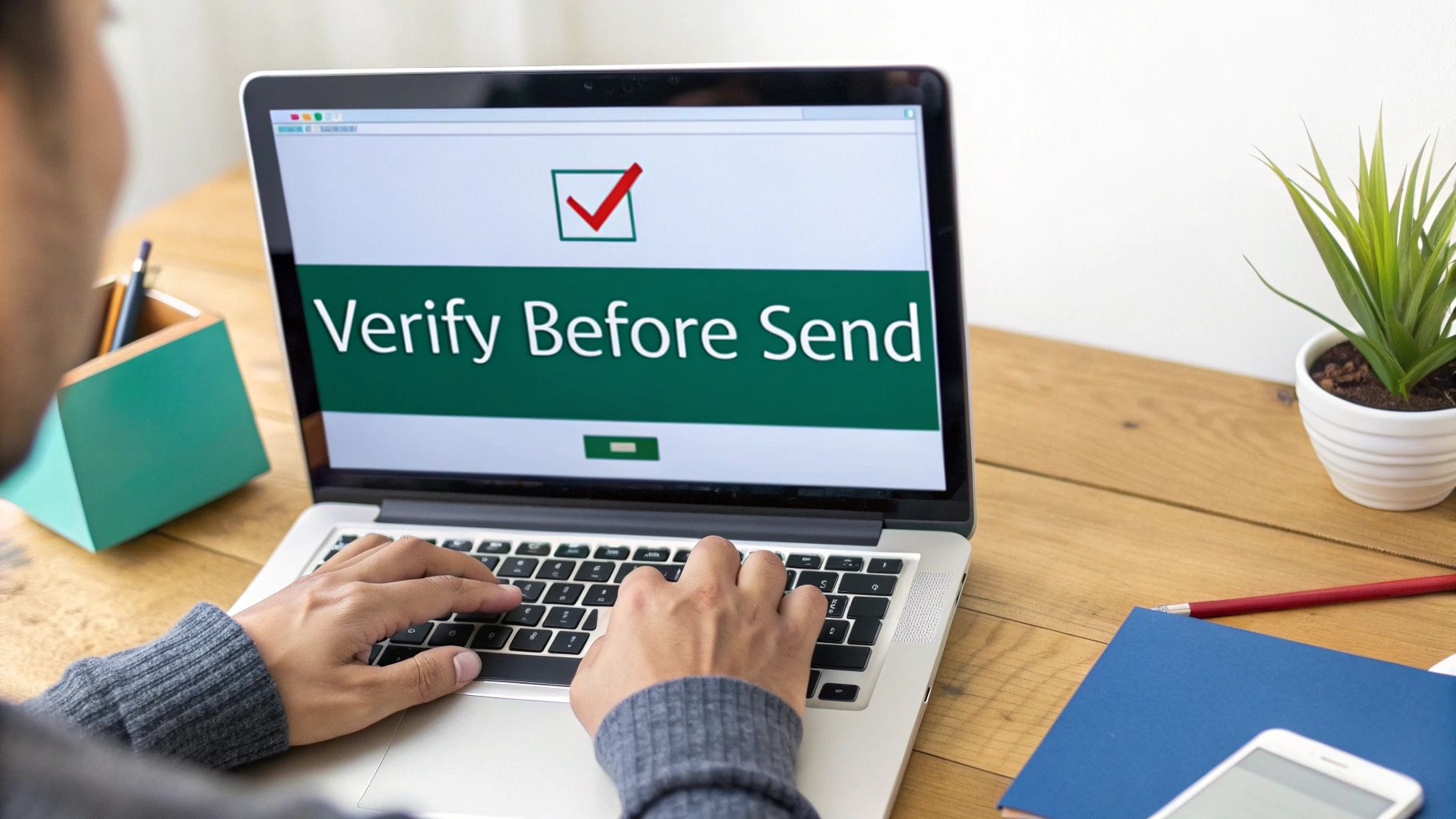
Navigating Data Privacy Laws
Beyond just playing by LinkedIn's rules, you have to think about data privacy regulations like GDPR in Europe and the CAN-SPAM Act in the U.S. These aren't just polite suggestions—they are laws with serious teeth.
Here’s a quick rundown of what they demand for professional outreach:
- Be Transparent: Clearly state who you are and why you're reaching out. No hiding behind a vague subject line or a mysterious company name.
- Provide Value: Your message needs to offer something relevant to the person you're emailing. A generic, copy-pasted sales pitch just doesn't cut it.
- Offer an Easy Opt-Out: Every single email must include a clear and simple way for someone to unsubscribe from future messages. No questions asked.
Getting these fundamentals right is non-negotiable. If you want to dig deeper, our guide on https://emailscout.io/lead-generation-best-practices/ lays out more detailed strategies for staying compliant and effective.
The core principle of ethical outreach is simple: treat others' inboxes the way you'd want yours to be treated. Respect, relevance, and transparency are your best tools for building trust.
Tailoring Your Approach
How effective your outreach is also depends on who you're contacting. For example, professionals aged 25–34 make up a whopping 47% of LinkedIn’s user base—an audience that's generally pretty open to networking.
But here’s the catch: only about 1% of active users share content weekly, and even fewer list their emails publicly. This means your strategy has to be precise.
Privacy norms also change depending on where you are in the world. Professionals in North America are often more open to sharing contact details than their counterparts in regions with stricter privacy cultures. This just means what works for a contact in one industry or country might need a little tweaking for another.
Common Questions About Finding Emails
When you start digging for emails on LinkedIn, a few questions always pop up. It's totally normal to wonder about the rules, how reliable these tools are, and what to do when you hit a dead end. Let's clear the air so you can move forward with confidence.
Is It Legal to Find Emails This Way?
This is the big one, and the answer isn't a simple yes or no—it's layered. Whether it's legal to use an email you found on LinkedIn depends on where you are, where your prospect is, and what you're sending.
Laws like GDPR in Europe and the CAN-SPAM Act in the U.S. have strict rules about commercial emails. The good news is that B2B outreach for a legitimate business interest is usually fine. The catch? You have to be transparent, offer real value, and give them an easy way to opt out. Always do your homework on the specific rules that apply to you.
It's also worth noting that using aggressive scraping tools can get you in trouble with LinkedIn's terms of service, which is a separate issue from the law. You could face account penalties for that.
The bottom line is this: finding the email is just the first step. It's how you use it that matters. Always lead with respect and give people a clear way out.
How Accurate Are Email Finder Tools?
A good email finder tool will usually hit an accuracy rate of 70% to 90%. The best ones get there by checking multiple public sources and running a quick verification in real-time to see if the email address is live.
But nothing's perfect. Accuracy can dip for smaller companies, people with super common names, or businesses that use weird email patterns. That's why it's a smart move to run your list through a separate email verification service, especially before launching a big campaign. It's a simple step that protects your sender reputation by keeping your bounce rate low.
What if I Still Can't Find an Email?
So you've tried all the manual tricks and fired up a tool, but you're still coming up empty. Don't give up on the prospect just yet. It's just time to switch gears.
Forget the email for a minute and go back to the source: LinkedIn itself.
Send a personalized connection request that gets straight to the point about why you want to connect. If they accept, follow up with a short, value-packed InMail message. The goal is just to start a conversation right there on the platform. More often than not, if you build a little rapport first, they’ll be happy to share their email with you down the line.
Can an Email Finder Get My Account Banned?
There’s always a small risk when you use third-party tools, since LinkedIn’s user agreement technically forbids automated data scraping. But top-tier extensions like EmailScout are designed to fly under the radar. They do this by acting more like a human and putting reasonable caps on how many searches you can do at once.
To play it safe, just follow a few common-sense rules:
- Steer clear of bots that automate tons of profile visits or connection requests.
- Don't go crazy with your daily email lookups. Keep it reasonable.
- Only use trusted, high-quality extensions that are open about how they work.
Stick with tools that play fair, and you can get the tech advantage without putting your account on the line.
Ready to stop guessing and start connecting? The EmailScout Chrome extension gives you instant access to verified email addresses right on LinkedIn profiles. Find unlimited emails for free and build your prospect lists in a single click.

